How do I register a custom protocol with Windows so that when clicking a link in an email or on a web page my application is opened and the parameters from the URL are passed to it?
-
Possible duplicate of [how do I create my own URL protocol? (e.g. so://...)](http://stackoverflow.com/questions/389204/how-do-i-create-my-own-url-protocol-e-g-so) – phuclv Apr 30 '17 at 08:07
-
If you are using python, you can install [simpler](https://pypi.org/project/simpler/) and use [register_protocol_handler](https://simpler.readthedocs.io/en/latest/simpler.terminal.html#simpler.terminal.register_protocol_handler). – Carlos Roldán Oct 27 '22 at 23:12
6 Answers
Go to Start and then in Find, type *regedit. It should open the Registry editor
Right-click on HKEY_CLASSES_ROOT and then `New* → Key
In the Key, enter the lowercase name by which you want URLs to be called (in my case, it will be testus://sdfsdfsdf). Then right-click on testus. Then New → String Value and add URL Protocol without value.
Then add more entries like you did with protocol (Right-click New → Key) and create a hierarchy like testus → shell → open → command. Inside command, change (Default) to the path where the .exe file you want to launch is. If you want to pass parameters to your EXE file, then wrap the path to the EXE file in
""and add"%1"to make it look like:"c:\testing\test.exe" "%1"To test if it works, go to Internet Explorer (not Chrome or Firefox) and enter
testus:have_you_seen_this_man. This should fire your.exe(it gives you some prompts that you want to do this; say Yes) and passtestus://have_you_seen_this_maninto arguments.
Here's a sample console application to test:
using System;
namespace Testing
{
class Program
{
static void Main(string[] args)
{
if (args!= null && args.Length > 0)
Console.WriteLine(args[0]);
Console.ReadKey();
}
}
}
- 30,738
- 21
- 105
- 131
- 58,075
- 31
- 238
- 265
-
3
-
1
-
@MatasVaitkevicius can I specify "working directory for the application to run from" in registry(within custom URL protocol entry). Ex. for triggering a Batch file if I create a custom Url registry entry, the batch file runs from system32 when launched from browser irrespective of the location of the batch file, whereas if I run the batch file by double clicking it, then the working directory remains its current directory. – user1066231 Jul 30 '21 at 05:45
-
@user1066231 https://superuser.com/questions/396394/how-do-i-set-an-executables-working-directory-via-the-command-line-prior-to-ex ? – Matas Vaitkevicius Aug 04 '21 at 10:17
-
2@MatasVaitkevicius Thanks. yeah found the answer. posting here-may be usefull for someone else. https://stackoverflow.com/questions/68577785/how-to-make-url-protocol-to-launch-application-from-its-own-directory-instead?noredirect=1#comment121226027_68577785 – user1066231 Aug 04 '21 at 12:34
-
I've followed these steps, and using custom protocol "testus:foo" gets recognized from Run dialog in windows 7, but not from any of the browsers I tried, nor from the cmd shell. Any idea on what I could have done wrong or missed? – Joe Sep 20 '21 at 00:18
-
-
@WiiLF that would be a nice answer, you are welcome to use the stuff above to write it. I promise a +1 if you do. – Matas Vaitkevicius Dec 05 '21 at 08:40
-
Is there a way to do this in a cross-platform way? If not, how can it be done on Mac and Linux? – Aaron Franke Jun 08 '22 at 16:25
-
This doesn't work when I try to open a file with notepad. Notepad opens but with an empty text editor and an error message (https://imgur.com/MmXwxHL). Here is my setup https://imgur.com/pbb3v4D (I tried without the "" around %1 and adding another "" before "%1", without success). – MagTun Jul 13 '22 at 09:03
-
-
I did these steps but my program does not seem to run. I get the prompt about what this URL wants to open on my computer, this is ok. But I click OK and nothing happens. The app is supposed to create a log file and write the URL in it, but no file is created. Anybody has any idea what can be the problem? – pedro Feb 13 '23 at 12:36
-
@pedro put the breakpoint and see if your `Main` method gets hit, if not then most likely something with PATH to `.exe`. Could be a number of things like permissions and such. – Matas Vaitkevicius Feb 13 '23 at 12:47
[Obsolete - the MSDN information has been replaced by a new page which does address the security concerns]
The MSDN link is nice, but the security information there isn't complete. The handler registration should contain "%1", not %1. This is a security measure, because some URL sources incorrectly decode %20 before invoking your custom protocol handler.
PS. You'll get the entire URL, not just the URL parameters. But the URL might be subject to some mistreatment, besides the already mentioned %20->space conversion. It helps to be conservative in your URL syntax design. Don't throw in random // or you'll get into the mess that file:// is.
- 173,980
- 10
- 155
- 350
-
-
7There's no formal mapping of file: URLs to local paths. There's not even a consensus on the use of two or three leading slashes, or the use of forward versus backward slashes when the path refers to a Windows directory. – MSalters May 01 '09 at 12:51
-
Late comment, I know. But is it also possible to somehow access the URL parameters *only*, without the protocol handler? – Danilo Bargen May 12 '10 at 11:10
-
2That sounds like a separate question. Please do get your terms straight, though. The protocol handler is the program that receives the URL. "Without the protocol handler" there's nobody to parse the URL and access the URL parameters. – MSalters May 14 '10 at 08:01
-
Wrapping the path or the parameter in quotes makes no difference to the registry validity, some installers do it either way – WiiLF Dec 19 '21 at 16:56
-
1@WiiLF: Correct, the registry treats it as just a `REG_SZ`. And internally, Windows doesn't parse command lines so spaces are preserved as well. But any language runtime that parses a command line (such as C's `argv[]`parsing) will break on an unquoted space. – MSalters Dec 20 '21 at 09:10
-
This answer appears to be referring to an MSDN link that isn't in the question or this answer. Answers should be fully self contained and not rely on external links nor should they reference links that aren't specifically part of the question. – Micah Zoltu Mar 21 '23 at 09:21
If anyone wants a .reg file for creating the association, see below:
Windows Registry Editor Version 5.00
[HKEY_CLASSES_ROOT\duck]
"URL Protocol"=""
[HKEY_CLASSES_ROOT\duck\shell]
[HKEY_CLASSES_ROOT\duck\shell\open]
[HKEY_CLASSES_ROOT\duck\shell\open\command]
@="\"C:\\Users\\duck\\source\\repos\\ConsoleApp1\\ConsoleApp1\\bin\\Debug\\net6.0\\ConsoleApp1.exe\" \"%1\""
Pasted that into notepad, the file -> save as -> duck.reg, and then run it. After running it, when you type duck://arg-here into chrome, ConsoleApp1.exe will run with "arg-here" as an argument. Double slashes are required for the path to the exe and double quotes must be escaped.
Tested and working on Windows 11 with Edge (the chrome version) and Chrome
- 747
- 14
- 31
-
what happens if the registration already exists? does this `reg` override it? – Nitin Sawant Apr 22 '23 at 23:34
-
There is an npm module for this purpose.
link :https://www.npmjs.com/package/protocol-registry
So to do this in nodejs you just need to run the code below:
First Install it
npm i protocol-registry
Then use the code below to register you entry file.
const path = require('path');
const ProtocolRegistry = require('protocol-registry');
console.log('Registering...');
// Registers the Protocol
ProtocolRegistry.register({
protocol: 'testproto', // sets protocol for your command , testproto://**
command: `node ${path.join(__dirname, './index.js')} $_URL_`, // $_URL_ will the replaces by the url used to initiate it
override: true, // Use this with caution as it will destroy all previous Registrations on this protocol
terminal: true, // Use this to run your command inside a terminal
script: false
}).then(async () => {
console.log('Successfully registered');
});
Then suppose someone opens testproto://test then a new terminal will be launched executing :
node yourapp/index.js testproto://test
It also supports all other operating system.
- 538
- 5
- 12
-
Is there a cross-platform tool like this available as a C++ library? – Aaron Franke Jun 08 '22 at 16:37
-
Hi there is a cli version of this available as "protocol-registry-cli" You can use it and run it through c++ – Shubham Kumar Aug 02 '22 at 18:47
To further the existing answers a bit more, the application invoked to handle the protocol does not have to be a compiled application. It can also be a script file.
For example, you could create a Windows batch file - such as that below to - handle the call. Let us assume you save that script to c:\temp\testprotocol-handler.bat.
REM just echo the passed argument
echo off
echo Hello from the custom protocol handling script.
echo script name: %0
echo script arg : %1
pause
Use the following registry configuration to map the script to the protocol testprotocol.
Windows Registry Editor Version 5.00
[HKEY_CLASSES_ROOT\testprotocol]
"URL Protocol"=""
[HKEY_CLASSES_ROOT\testprotocol\shell]
[HKEY_CLASSES_ROOT\testprotocol\shell\open]
[HKEY_CLASSES_ROOT\testprotocol\shell\open\command]
@="\"C:\\temp\\testprotocol-handler.bat\" \"%1\""
When the OS encounters the protocol it will execute the script - opening a command window and displaying the content of the echo statements in the script.
- 972
- 9
- 22
@echo off
setlocal
set "protocol_name=sugamprotocol"
set "application_path=C:\Users\%USERNAME%\Downloads\ping_execute.exe"
set "key_path=HKCU\SOFTWARE\Classes\%protocol_name%"
set "command_path=%key_path%\shell\open\command"
REM Create the registry key for the custom protocol handler
reg add "%key_path%" /ve /d "URL:Custom Protocol" /f > nul
reg add "%key_path%" /v "URL Protocol" /d "" /f > nul
REM Create the command key to specify the application to run
reg add "%command_path%" /ve /d "\"%application_path%\" \"%%1\"" /f > nul
echo Custom protocol handler registered successfully!
endlocal
To create the .bat file, open a text editor, copy the above code, and save the file with a .bat extension (e.g., register_protocol.bat). Make sure to adjust the protocol_name and application_path variables according to your requirements.
When you run the .bat file, it will register the custom protocol handler by modifying the Windows registry. You should see the "Custom protocol handler registered successfully!" message if the registration is successful.
Please note that modifying the Windows registry requires administrative privileges. Make sure to run the .bat file as an administrator.
- 1
- 3
-
1Many of your answers here, including several which you've made Community Wikis for some reason, appear likely to have been entirely or partially written by AI (e.g., ChatGPT). Please be aware that [posting AI-generated content is not allowed here](//meta.stackoverflow.com/q/421831). If you used an AI tool to assist with any answer, I would encourage you to delete it. – NotTheDr01ds Jul 03 '23 at 00:27
-
1**Readers should review this answer carefully and critically, as AI-generated information often contains fundamental errors and misinformation.** If you observe quality issues and/or have reason to believe that this answer was generated by AI, please leave feedback accordingly. The moderation team can use your help to identify quality issues. – NotTheDr01ds Jul 03 '23 at 00:28


